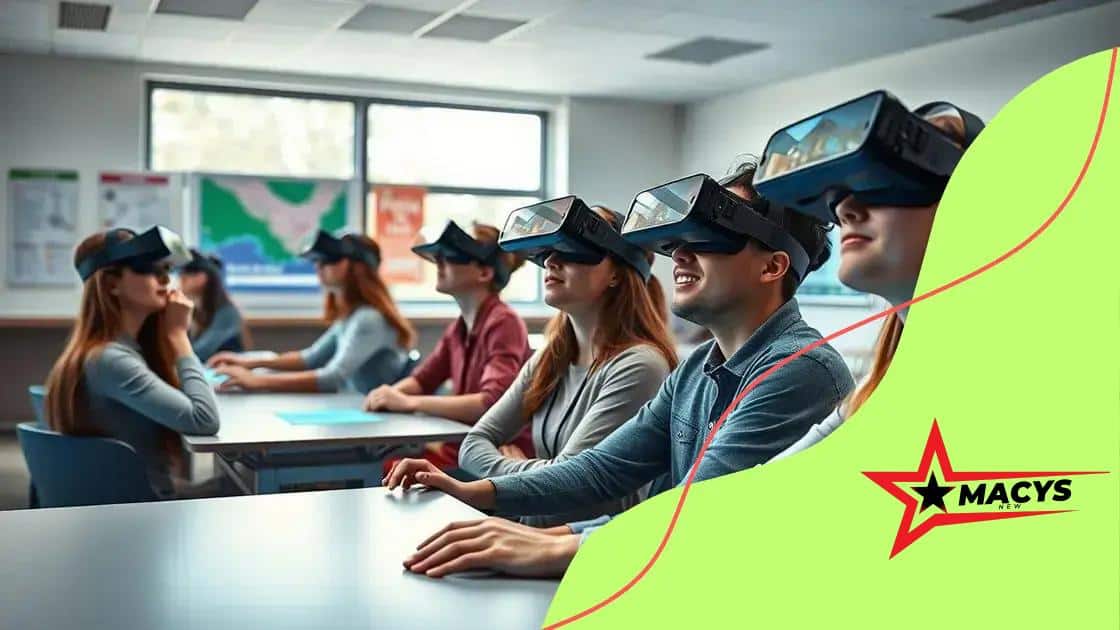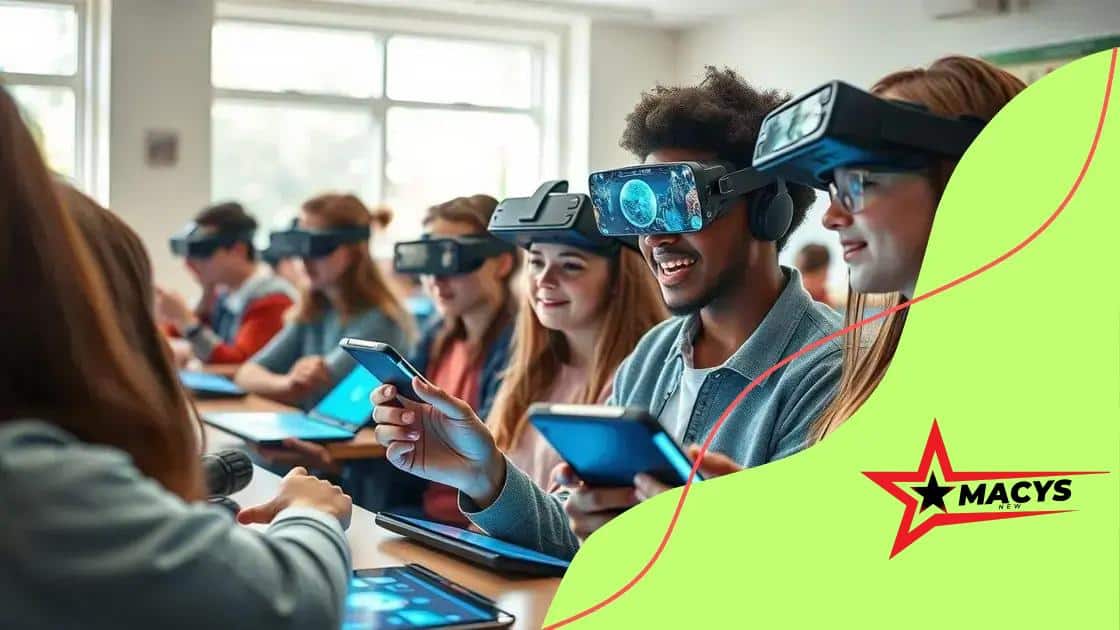How AR is being used for hands-on learning experiences

Augmented Reality (AR) is transforming hands-on learning experiences by providing interactive, personalized, and immersive educational tools that enhance student engagement and understanding in classrooms.
How AR is being used for hands-on learning experiences is changing the way students engage with material. Have you ever imagined how immersive technology can bring traditional lessons to life? Let’s dive into the possibilities.
Understanding augmented reality in education
Understanding augmented reality in education is crucial for embracing modern learning techniques. With the integration of AR technology, students can experience interactive learning that goes beyond textbooks. This educational innovation engages students age 7 and up by merging the virtual world with the physical environment.
What is augmented reality?
Augmented reality enhances real-world experiences by overlaying digital information onto the physical space. This means students can visualize complex concepts, such as anatomy or geography, right in front of them. Imagine a biology lesson where students can see a 3D model of a heart and understand how blood flows through it.
How AR enhances learning experiences
By using AR tools, educators can create lessons that are more engaging and effective. Let’s explore some benefits:
- Provides interactive learning experiences that improve retention.
- Encourages collaboration among students during group projects.
- Makes learning fun, which motivates students to participate.
Furthermore, AR applications can take students on virtual field trips without leaving the classroom. Imagine traveling through ancient Rome or diving into the ocean to explore marine life, all while seated at their desks.
Real-world examples of AR in education
Many schools have started using AR solutions in their curriculums. For instance, a local high school adopted an AR app for their chemistry classes. Students use tablets to see molecular structures in 3D while conducting experiments, solidifying their understanding of chemical reactions.
Additionally, museums are now using AR experiences to enhance visits. Guests can scan artifacts with their smartphones to unlock immersive content, making history come alive. This blend of education and technology keeps learners engaged and curious about the world around them.
Benefits of AR in hands-on learning
The benefits of AR in hands-on learning are transforming the educational landscape. As augmented reality technology gains popularity, teachers and students alike are discovering how it can enhance the learning experience. This innovation not only makes lessons more engaging but also helps students better understand complex topics.
Engagement and motivation
Using AR tools can significantly boost student engagement. When students interact with lessons through immersive visuals, they become more invested in their learning. For example, a student studying geology might use an AR app to view the layers of the Earth’s crust, visually interacting with materials that help solidify their understanding.
Improved retention of information
Another key benefit of AR is its ability to enhance information retention. Studies show that learners retain more when they experience educational content in an interactive way. Here are some reasons why AR helps with retention:
- Visual aids create clearer mental images.
- Hands-on activities solidify concepts.
- Interactive experiences make learning memorable.
Furthermore, students enjoy the learning process more when it involves AR experiences, which leads to deeper understanding and longer-lasting knowledge.
Personalized learning experiences
Augmented reality provides opportunities for personalized learning. Every student learns differently, and AR can cater to various learning styles. For instance, visual learners can benefit from seeing concepts in 3D, while kinesthetic learners gain from interactive features that allow them to manipulate objects. This adaptability is essential in today’s diverse classrooms.
As educators embrace AR, they can tailor content to meet individual needs, fostering an environment where all students can thrive. By blending real-world applications with educational material, AR makes learning applicable and exciting for students.
Interactive tools for effective AR experiences

Interactive tools for effective AR experiences are essential for maximizing the learning potential of students. Using augmented reality technologies can transform simple lessons into engaging adventures that capture the imagination of learners. With the right tools, educators create immersive environments where students can explore and learn actively.
Types of interactive AR tools
There are various types of AR tools that educators can use to enhance their teaching methods. These tools can range from simple apps to complex systems that integrate with classroom technology. Here are some popular tools:
- AR applications: Educational apps that bring subjects to life, such as anatomy or historical events.
- AR glasses: Wearable devices that provide augmented content in the user’s field of vision.
- Interactive projections: Technologies that allow teachers to project 3D models or interactive scenarios on surfaces.
Using these tools, students can visualize concepts and interact with the material in a way that traditional teaching methods cannot provide.
Benefits of using interactive tools
Incorporating interactive AR tools in the classroom offers numerous benefits for students and educators alike. First, these tools cater to different learning styles, allowing visual, auditory, and kinesthetic learners to thrive. Moreover, students stay motivated and engaged when they can touch, manipulate, and explore educational content through AR.
Additionally, the immediate feedback provided by interactive tools helps students correct misunderstandings and deepen their knowledge. When students receive instant responses to their queries, it fosters a proactive learning environment. By enabling exploration and experimentation, educators can encourage critical thinking and problem-solving skills.
As these technologies evolve, they continue to transform the way students experience learning. Classroom dynamics change as students participate more actively, collaborating with peers and teachers to explore complex topics in exciting new ways.
Case studies: AR in real-world classrooms
Case studies of AR in real-world classrooms show the profound impact that augmented reality can have on education. Schools around the world have begun integrating AR technology into their curricula to enhance student engagement and improve learning outcomes. These examples highlight how AR can transform traditional lessons into interactive experiences.
Example 1: Anatomy learning through AR
At a local high school, biology students use an AR application called “Anatomy 4D”. This app allows them to visualize and interact with 3D models of human organs. Students can examine different systems, such as the circulatory and respiratory systems, in a way that textbooks alone cannot provide. By rotating and viewing these organs from various angles, students gain a clearer understanding of their functions.
Example 2: History lessons brought to life
Another school implemented an AR program that immerses students in historical events. Using a specific AR tool, students can point their devices at specific locations on a map and see historical figures appear in 3D. This interactive method allows students to visualize key moments in history, making the subject come alive in a way that traditional lessons could not achieve.
Example 3: Hands-on learning in science
A middle school in California adopted an AR tool for its science classes. With augmented reality, students conduct virtual experiments in a safe environment. For instance, they can mix chemicals in a virtual lab, observing the reactions without the risks associated with real-life experiments. This hands-on approach not only promotes safety but also enriches student learning by providing a more engaging way to explore scientific concepts.
These case studies demonstrate that AR technology is not just a trend but a valuable resource in education. By leveraging AR, educators can create environments that encourage exploration and interaction. The increasing integration of AR in real classrooms signifies a shift towards more dynamic and effective teaching methods.
Future trends in augmented reality learning
Future trends in augmented reality learning are poised to revolutionize education in exciting new ways. As AR technology evolves, it will open the door to unprecedented learning methods that enhance student engagement and understanding. Innovators are constantly working to improve AR tools, making them more accessible and interactive.
Increased interactivity
One major trend is the shift towards more interactive experiences. In the future, students will not only view content but also interact with it in real-time. Imagine a science class where students can experiment with virtual lab equipment, or a history lesson where they can engage with virtual reenactments. This level of interactivity will help students connect with the material on a deeper level.
Personalized learning experiences
Another emerging trend is the personalization of learning. AR will allow teachers to create customized experiences tailored to each student’s learning pace and style. By analyzing student performance data, AR systems can adjust the difficulty of tasks or suggest different educational pathways. This personalized approach fosters better learning outcomes and keeps students motivated.
- Adaptive learning tools: Systems that change content difficulty based on student needs.
- Customizable content: Educators can create lessons that fit their curriculum.
- Individual feedback: AR tools can provide instant feedback for students.
Moreover, the use of AI in AR is set to expand, leading to smarter educational tools that learn from student interactions. These advancements will ensure that AR continues to be an effective learning aid.
Integration with virtual reality
As both technologies advance, expect to see a blended approach, combining augmented reality with virtual reality (VR). This fusion will create fully immersive environments that provide students with hands-on experiences that were previously unimaginable. Picture a student exploring the depths of the ocean or walking through ancient cities, all from their classroom.
Such immersive experiences will allow students to learn through exploration and inquiry, making lessons more impactful. The future of learning with AR holds immense potential, aiding teachers in creating vibrant, engaging classrooms.
FAQ – Frequently Asked Questions about AR in Education
How does augmented reality enhance learning?
Augmented reality enhances learning by providing interactive experiences that engage students and help them visualize complex concepts.
What are some examples of AR tools used in classrooms?
Examples of AR tools include apps that create 3D models for science lessons, AR glasses for immersive experiences, and interactive projection systems.
Can AR be personalized for different learning styles?
Yes, AR can be personalized to cater to various learning styles, adapting content and challenges to fit individual student needs.
What future trends can we expect in AR education?
Future trends include increased interactivity, integration with virtual reality, and smarter tools that provide personalized feedback and adapt to student performance.





